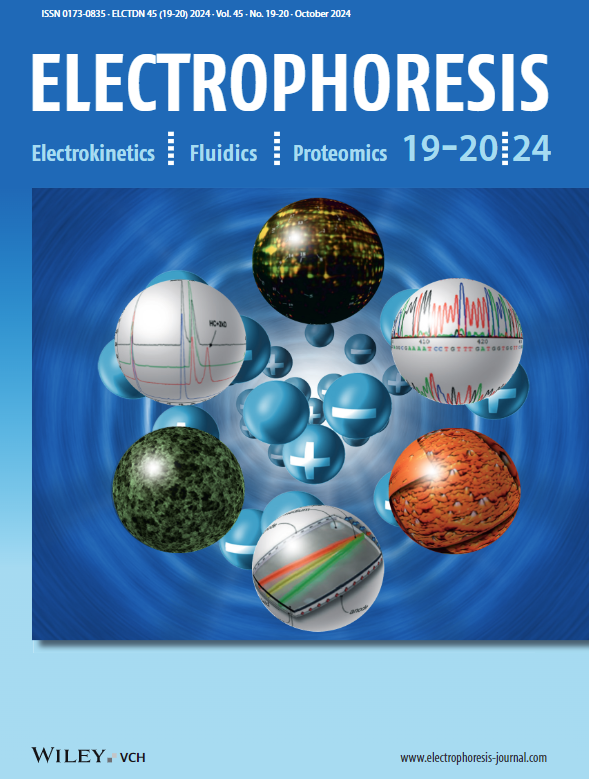十二烷基硫酸钠-毛细管凝胶电泳与天然荧光检测定量蛋白质治疗药物的关键质量属性。
IF 2.5
3区 生物学
Q2 BIOCHEMICAL RESEARCH METHODS
引用次数: 0
摘要
在生物制药行业,十二烷基硫酸钠-毛细管凝胶电泳(SDS-CGE)检测通常用于评估治疗关键质量属性(cqa)。传统的SDS-CGE检测方法,如紫外(UV)吸光度和激光诱导荧光(LIF),被广泛使用,但存在局限性。一种原生荧光检测(NFD)方案在不需要样品衍生化的情况下提高了灵敏度,减少了凝胶基质的干扰,SDS-CGE-NFD检测在单克隆抗体(mab)的绝对定量方面具有很高的精度和准确性。在这项工作中,我们评估了SDS-CGE-NFD对蛋白质治疗中cqa定量的适用性,这通常是相对的而不是绝对的。将NFD与紫外吸光度和LIF检测在SDS-CGE中定量蛋白质治疗药物的cqa进行比较。对3批NIST单克隆抗体(NISTmAb)进行SDS-CGE检测,并结合NFD、UV和LIF检测,比较总片段的相对丰度,发现相似。NFD分析测得的丰度范围为1.77%-2.00%,而紫外吸收法测得的丰度范围为1.53%-1.78%,LIF测得的丰度范围为1.63%-1.86%。聚集体没有被紫外吸收光谱识别出来,但聚集体明显,NFD和LIF的相对丰度分别为0.38% ~ 0.40%和0.35% ~ 0.40%。在还原条件下,三种检测方法在重链上的糖基化位点占用率均在99.30% ~ 99.33%之间。三种检测模式的比较结果表明,SDS-CGE-NFD适用于定量蛋白质治疗药物的cqa。SDS-CGE-NFD工作流程成功地应用于分析两种商业蛋白质疗法,一种双特异性单抗(Emicizumab)为~ 146 kDa,一种fc融合蛋白为~ 63 kDa (Dulaglutide)。本文章由计算机程序翻译,如有差异,请以英文原文为准。
Quantifying Critical Quality Attributes of Protein Therapeutics by Sodium Dodecyl Sulfate-Capillary Gel Electrophoresis With Native Fluorescence Detection.
[08-08-2025]: This article published in Early View in error and has been taken down temporarily. The article will republish shortly.
求助全文
通过发布文献求助,成功后即可免费获取论文全文。
去求助
来源期刊

ELECTROPHORESIS
生物-分析化学
CiteScore
6.30
自引率
13.80%
发文量
244
审稿时长
1.9 months
期刊介绍:
ELECTROPHORESIS is an international journal that publishes original manuscripts on all aspects of electrophoresis, and liquid phase separations (e.g., HPLC, micro- and nano-LC, UHPLC, micro- and nano-fluidics, liquid-phase micro-extractions, etc.).
Topics include new or improved analytical and preparative methods, sample preparation, development of theory, and innovative applications of electrophoretic and liquid phase separations methods in the study of nucleic acids, proteins, carbohydrates natural products, pharmaceuticals, food analysis, environmental species and other compounds of importance to the life sciences.
Papers in the areas of microfluidics and proteomics, which are not limited to electrophoresis-based methods, will also be accepted for publication. Contributions focused on hyphenated and omics techniques are also of interest. Proteomics is within the scope, if related to its fundamentals and new technical approaches. Proteomics applications are only considered in particular cases.
Papers describing the application of standard electrophoretic methods will not be considered.
Papers on nanoanalysis intended for publication in ELECTROPHORESIS should focus on one or more of the following topics:
• Nanoscale electrokinetics and phenomena related to electric double layer and/or confinement in nano-sized geometry
• Single cell and subcellular analysis
• Nanosensors and ultrasensitive detection aspects (e.g., involving quantum dots, "nanoelectrodes" or nanospray MS)
• Nanoscale/nanopore DNA sequencing (next generation sequencing)
• Micro- and nanoscale sample preparation
• Nanoparticles and cells analyses by dielectrophoresis
• Separation-based analysis using nanoparticles, nanotubes and nanowires.
 求助内容:
求助内容: 应助结果提醒方式:
应助结果提醒方式:


